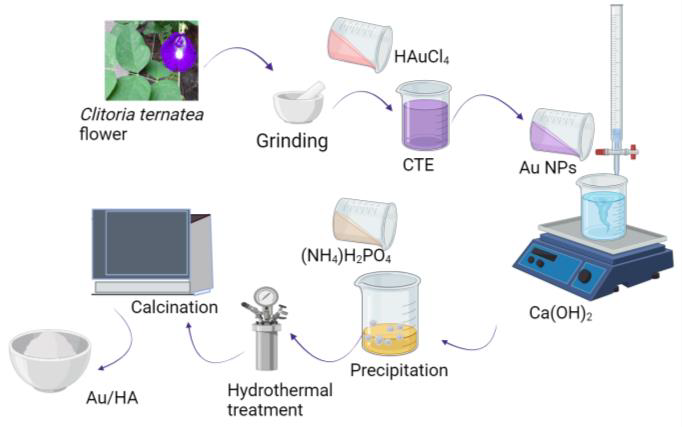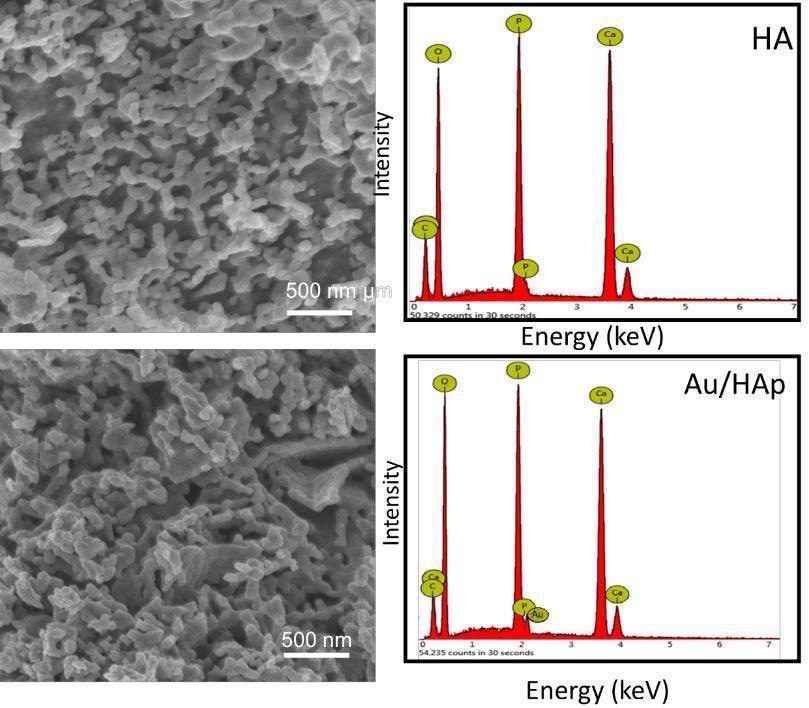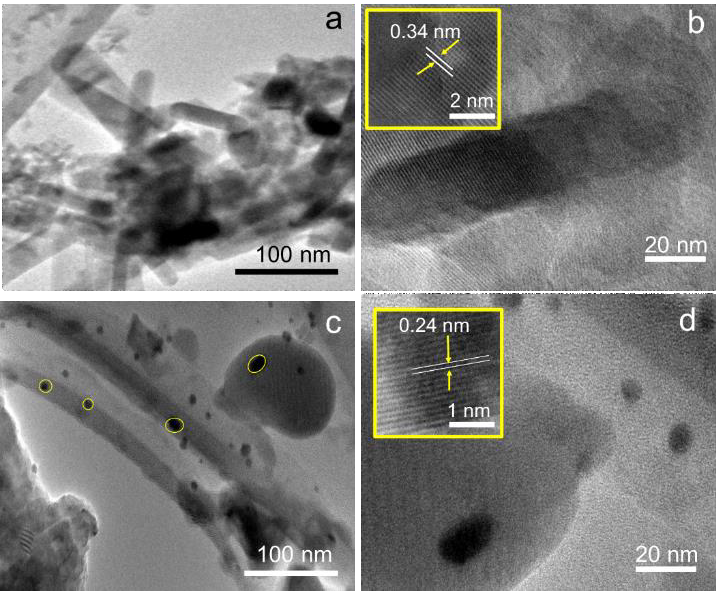Hydroxyapatite (HA) and gold nanoparticles (AuNP) are attracting increasing attention in nano research as being serious contenders for widespread application in biomedical technologies. Researchers in the journal Materials Research Express have recently developed a biosynthesized hydroxyapatite gold nanocomposite (Au/HA) that demonstrated enhanced antibacterial and antioxidant activity.
 Figure 1. Schematic diagram of the synthesis of Au/HA
Figure 1. Schematic diagram of the synthesis of Au/HA
Study: Biosynthesized gold nanoparticles-doped hydroxyapatite as antibacterial and antioxidant nanocomposite. Image: Butterfly Pea (Clitoria ternatea), Credit: YuRi Photolife / Shutterstock
Compared to other metal nanomaterials, gold nanoparticles exhibit high-performance qualities against a number of pathogens, as well as demonstrating antibacterial and antioxidant properties. In recent years, hydroxyapatite has attracted increased interest and application in biomedicine due to its resemblance to the mineral part found in human hard tissue found in bones and teeth.

Schematic diagram of the synthesis of Au/HA. Image Credit: Materials Research Express
Therefore, the development of a new biosynthesized hydroxyapatite gold nanocomposite (Au/HA) makes for exciting reading due to its potential as an innovative material. The primary use for the nanocomposite would be applied in the biomedical field.
“The nanocomposite exhibited antioxidant activity which provides a reference for designing and developing novel antibacterial materials for various applications, especially as an antibacterial component in biomedical technology,” stated lead author, Professor Is Fatimah of Universitas Islam Indonesia.
The biosynthesis of nanoparticles is a straightforward, single-step, environmentally friendly green approach. The biochemical processes in biological agents reduce the dissolved metal ions into nanometals. Different biological agents used in the process such as plant tissues, fungi, bacteria, etc. are used for the biosynthesis of metal nanoparticles.
The researchers developed their nanocomposite by reducing chloroauric acid (HAuCl4), a precursor to gold nanoparticles, using a Clitoria ternatea flower extract utilized in hydroxyapatite synthesis. The primary aim of the research was to analyze the structure of the composite and carry out antibacterial testing across various strains including E. Coli.

SEM images and XRF spectra of HA and Au/HA. Image Credit: Materials Research Express
Hydroxyapatite Applications
Hydroxyapatite of biological or synthetic origin is currently being applied in bone repair and regeneration scenarios; typically a granular form is used in conjunction with scaffolding supports. The material can be used on its own or as part of a composite with ceramics, polymers, or even certain groups of metals to help repair or rebuild hard tissue.
As previously mentioned, the rationale of hydroxyapatite use is in part due to the similarity in composition to bone material. In addition to composition similarity, hydroxyapatite exhibits good biocompatibility with soft tissue—muscle, skin, and gums.
There are numerous critical bone defects the arise from degenerative disease, high-impact trauma, and tumor restriction that cannot repair through the body’s natural self-healing mechanisms. Therefore, biotech solutions are required in order to address these problems.
However, researchers believe that to address certain limitations that come with using hydroxyapatite, developing new nanocomposites will help produce more sophisticated and efficient materials to advance practical application uses.
As a result of the rapid progress being made in nanoscience and nanotech, nanoparticle-based biomaterials are becoming increasingly sought after in certain areas of biomedical technology such as tissue engineering.

TEM and HRTEM images of HA and Au/HA. Image Credit: Materials Research Express
Antibacterial Gold Nanoparticles
Gold Nanoparticles are non-toxic and can be easily acquired using diverse synthesis methods. They show great potential for enhancing antibacterial effects. This antibacterial effect is a result of the interaction of the material with cell barriers or biomolecules within bacteria.
While previous research has hinted at the therapeutic potential of gold nanoparticles, the true antibacterial effect was considered a gray area and in some corners a controversial claim. However, the advanced characteristics of nanomaterials offer an opportunity to explore and enhance their antibacterial activities for clinical applications.
Additionally, there is growing evidence that suggests that gold nanoparticles are promising osteoinductive biomaterials for bone tissue engineering and regeneration. Gold nanoparticles have also been widely used for the preparations of biologic therapies, including photothermal therapies, drug delivery systems, diagnostic reagents, biosensors, etc.
Results
Fatimah and her team have recorded that their nanocomposite does serve as a reference point for designing antibacterial and antioxidizing materials. For comparison, the team tested the biosynthesized nanocomposite against both gold nanoparticles and hydroxyapatite alone.
While the gold nanoparticles demonstrated the greatest antibacterial activity, the composite also demonstrated “strong” antibacterial activity which was correlated with the capability of the gold nanoparticles to destroy bacterial membranes.
“The composite showed the nanoparticles dispersed in the composite giving influence for the homogeneous performance as well as the antibacterial activity,” Fatimah stated.
Furthermore, the composite also demonstrated good antioxidant activity, which makes the nanocomposite a good candidate for potential application in advanced artificial organ development.
Thus, this research demonstrates excellent theoretical innovation in both its approach to biosynthesizing the hydroxyapatite gold nanocomposite as well as anticipating potential clinical uses in the future.
References:
Is Fatimah, Putwi Widya Citradewi, Amri Yahya, Bambang Nugroho, Habibi Hidayat, Gani Purwiandono, Suresh Sagadevan, Sheikh Ghazali and Shariff Ibrahim, ‘Biosynthesized gold nanoparticles-doped hydroxyapatite as antibacterial and antioxidant nanocomposite’, Materials Research Express, 2021. https://iopscience.iop.org/article/10.1088/2053-1591/ac3309/meta
Disclaimer: The views expressed here are those of the author expressed in their private capacity and do not necessarily represent the views of AZoM.com Limited T/A AZoNetwork the owner and operator of this website. This disclaimer forms part of the Terms and conditions of use of this website.